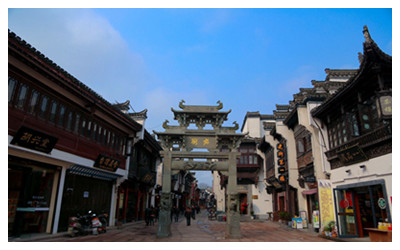Anhui is located in the eastern part of China. It is an integral part of the country’s most economically dynamic region—the Yangtze River Delta. Anhui Province was founded in 1667 and has a proud history of more than 300 years.

Early in the Qing Dynasty, a huge province named Jiangnan, was founded. It included what are now Anhui Province, Jiangsu Province and
Shanghai City. During the Qing Dynasty, in the sixth year of the reign of Emperor Kangxi (A.D.1667), Jiangnan Province was partitioned into two provinces: Anhui and Jiangsu. Anhui, the name of the province, is a portmanteau word combining the first characters of Anqing and
Huizhou. In the year when Anhui was established, Anqing was the political center of the province and
Huizhou was the economic center.
The province abbreviation is "Wan", because there were historically State of Wan, Mount Wan, and Wan River in the province.
It governs 16 cities, 9 county-level cities, 52 counties, 44 county-level districts, 259 sub-district offices and 1239 townships. By the end of 2019, the total number of registered population in Anhui had reached 71.194 million.
[Historical Evolution] Anhui is one of the most important cradles of China's pre-historical civilization. It has been discovered that even 2.5 million years ago, human beings already inhabited the site in the Inverted V Cave (the shape of the Chinese character of "man") in Fanchang County. The Hexian County's Sinanthropus Site of the Paleolithic Age (300,000 or 400,000 years ago) was excavated in the Dragon Pool Cave of Hexian County. These excavations have demonstrated that many generations of people have lived in this area since remote antiquity. During the Neolithic Age (between 4,000 and 10,000 years ago), Anhui belonged to the cultural domains of Yangshao, Longshan, Qingnianand Veined Chinaware.
The Xuejiagang Site, excavated in Qianshan County, has a long history of about 5,000 to 6,000 years. This ancient cultural site, revealing mostly Neolithic relics, is of great importance in the research of the primitive culture in the middle and lower reaches of the Yangtze River.
Yu, the historical reputed founder of the
Xia Dynasty (about 2070-1600 BC), had a close relation with Anhui. According to the historical records, Yu met with local lords at Tushan and all the lords paid tributes to him. Archeological research reveals that this historic event happened in today’s Bengbu.
Bozhou was once the capital of the Chengtang State in the
Shang Dynasty (between 1,600 to 1,046 BC), while the ancient Shouchun (today's Shouxian County) was the capital of the late Chu State in the Warring States Period (475-221 BC). The ancient copper tripod caldron excavated from the tombs of the Chu State is just little lighter than Houmuwu square cauldron, a bronze cooking vessel with two loop handles and four legs, of the
Shang Dynasty.
In the
Qin Dynasty (221-206 BC), according to the administrative division at that time, the area north to the Huai River belonged to Tang Prefecture and Sishui Prefecture, the area between the Huaihe River and the Yangtze River belonged to Jiujiang Prefecture, and the area south to the Yangtze River belonged to Zhang Prefecture.
During the East Han and West Han dynasties (206BC-220 AD), Anhui belonged to Yang, Yu, and Xu prefectures. In the period of the Three Kingdoms (220-280 AD), Anhui was dominated by the State of Wu and the State of Wei, and was a battle field innumerable times. In the period of the Jin Dynasty (265-420 AD), Southern and Northern dynasties (420-589 AD) and the Sui Dynasty (581-618 AD), Anhui belonged respectively to Yang, Xu and Yu prefectures. In the Song Dynasty (960-1279 AD), Hui merchants flourished quickly, the economy and culture of Hui Prefecture created great influence on the whole nation.
In the Yuan Dynasty (1206-1368 AD), Anhui was governed by Henan Province, Jiang and Zhe administrative provinces. In the Ming Dynasty (1368-1644 AD), Anhui was under the direct administration of the Capital of Nanjing, and the province was subdivided into seven prefectures and four counties: Anqing, Huizhou, Ningguo, Chizhou, Taiping, Luzhou and Fengyang prefectures, and Chu, He, Xu and Guangde counties. In the
Qing Dynasty (1616-1911 AD), Anhui was set up as a province with eight prefectures and five counties: Huizhou, Ningguo, Chizhou Taiping Anqing, Luyang, Fengyang, Yingzhou prefectures, and Guangde, Chu, He, Lu'an counties. At the beginningof the Republic of
China (1912-1949), Anhui was divided into Wuhu, Anqing, and Huaisi prefectures.
After the founding of the People's Republic of
China in 1949, Anhui was divided into the two prefectures: Northern Anhui and Southern Anhui, with Hefei as the capital of Northern Anhui and Wuhu the capital of Southern Anhui. In 1952, North Anhui and Southern Anhui were merged to form Anhui Province, and Hefei was selected as the provincial capital city.
 Early in the Qing Dynasty, a huge province named Jiangnan, was founded. It included what are now Anhui Province, Jiangsu Province and Shanghai City. During the Qing Dynasty, in the sixth year of the reign of Emperor Kangxi (A.D.1667), Jiangnan Province was partitioned into two provinces: Anhui and Jiangsu. Anhui, the name of the province, is a portmanteau word combining the first characters of Anqing and Huizhou. In the year when Anhui was established, Anqing was the political center of the province and Huizhou was the economic center.
Early in the Qing Dynasty, a huge province named Jiangnan, was founded. It included what are now Anhui Province, Jiangsu Province and Shanghai City. During the Qing Dynasty, in the sixth year of the reign of Emperor Kangxi (A.D.1667), Jiangnan Province was partitioned into two provinces: Anhui and Jiangsu. Anhui, the name of the province, is a portmanteau word combining the first characters of Anqing and Huizhou. In the year when Anhui was established, Anqing was the political center of the province and Huizhou was the economic center. Ask Questions ?
Ask Questions ?